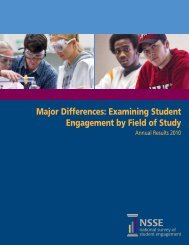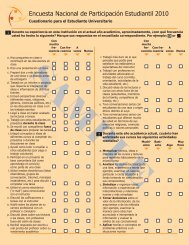2009 NSSE invite.indd - NSSE - Indiana University Bloomington
2009 NSSE invite.indd - NSSE - Indiana University Bloomington
2009 NSSE invite.indd - NSSE - Indiana University Bloomington
Create successful ePaper yourself
Turn your PDF publications into a flip-book with our unique Google optimized e-Paper software.
<strong>NSSE</strong><br />
National Survey of<br />
Student Engagement<br />
<strong>2009</strong> Invitation to Participate<br />
“At a time when US standards<br />
for higher education are being<br />
evaluated in a competitive global<br />
context, <strong>NSSE</strong> data provide real<br />
insights into the qualities of the<br />
campus learning environment.”<br />
— Molly Corbett Broad, President,<br />
American Council on Education<br />
Register by September 18, 2008<br />
at www.nsse.iub.edu<br />
Sponsored by The Carnegie Foundation<br />
for the Advancement of Teaching
What is <strong>NSSE</strong>?<br />
More than 1,300 four-year colleges and universities in the United States<br />
and Canada have used the National Survey of Student Engagement to<br />
document the extent to which students, faculty, and institutions engage<br />
in empirically-proven educational activities and to inform programs and<br />
practices that foster student engagement. The <strong>NSSE</strong> instrument is short,<br />
reliable, and easy for students to complete. It asks undergraduates about<br />
their in- and out-of-class activities, what they feel they have gained from<br />
classes, their assessment of the quality of interactions with faculty and<br />
students, and other educationally-purposeful activities. The results are<br />
organized into five benchmarks of effective educational practice:<br />
Level of Academic Challenge<br />
Active and Collaborative Learning<br />
Student-Faculty Interaction<br />
Enriching Educational Experiences<br />
Supportive Campus Environment<br />
Why Should Institutions Participate in <strong>NSSE</strong>?<br />
Institutions can use <strong>NSSE</strong> data to measure aspects of the undergraduate<br />
experience inside and outside the classroom that are consistent with good<br />
practice in undergraduate education. Assessing student engagement is a<br />
central component of evaluating overall educational effectiveness.<br />
Participating schools use their <strong>NSSE</strong> results in many ways, including:<br />
Assessment and improvement<br />
Benchmarking<br />
Accountability<br />
Institutional research<br />
Accreditation and self-studies<br />
Retention<br />
Curricular reform<br />
Alumni outreach<br />
Grant writing<br />
Recruitment<br />
Faculty and staff development<br />
State system comparisons<br />
Assessment of student satisfaction<br />
Performance indicators<br />
“<strong>NSSE</strong> is an institution’s most trustworthy lens for seeing<br />
deeply into the quality of students’ experiences. Its results<br />
translate directly into plans for action and strategies of<br />
reform and transformation.”<br />
2<br />
Hendrix College<br />
— Lee S. Shulman, President, The Carnegie Foundation for the<br />
Advancement of Teaching
What Does a Participating Institution Receive?<br />
Institutions receive detailed analyses and information tools, including:<br />
Customized Institutional Report – Presents your students’ responses by<br />
class year and provides statistical comparisons with three customized<br />
peer groups.<br />
Benchmark Report – Compares your students’ scores with those of peer<br />
institutions on the five <strong>NSSE</strong> benchmarks of effective educational practice.<br />
Institutional Data File – Includes raw student responses to all survey<br />
items, including student identifiers for additional in-depth analyses.<br />
Annual Report – Discusses data trends, <strong>NSSE</strong> initiatives, and the<br />
landscape of undergraduate assessment.<br />
Accreditation Toolkit – Highlights ways<br />
to incorporate <strong>NSSE</strong> data into regional<br />
and specialized accreditation efforts.<br />
Additional User Tools – Resources to support<br />
sharing your <strong>NSSE</strong> results with internal and<br />
external audiences via a facilitation guide,<br />
PowerPoint template, and more.<br />
For examples of<br />
these materials<br />
and additional<br />
information visit:<br />
www.nsse.iub.edu<br />
How Does <strong>NSSE</strong> Help Institutions<br />
Understand and Use Their Results?<br />
The <strong>NSSE</strong> Institute for Effective Educational Practice assists colleges and<br />
universities in using student engagement data to support institutional<br />
improvement and accountability efforts.<br />
Institute associates are available for:<br />
Facilitating regional and campus workshops and Webinars to<br />
stimulate discussion about ways to use <strong>NSSE</strong> data.<br />
Conducting assessments of campus conditions that promote<br />
student success.<br />
Evaluating the impact of curricular innovations and student<br />
success initiatives.<br />
Working with campuses, systems, and state organizations.<br />
Conducting research to better understand student success and<br />
educational effectiveness.<br />
3
“For several years we debated the need for substantive reform<br />
of our first-year curriculum. <strong>NSSE</strong> results provided evidence to<br />
persuade the faculty to change, and helped inform the new<br />
curriculum that we are now implementing.”<br />
Alaska Pacific <strong>University</strong><br />
— Richard F. Vaz, Dean for Interdisciplinary and Global Studies,<br />
Worcester Polytechnic Institute<br />
How is <strong>NSSE</strong> Administered?<br />
The survey is administered each spring term (February through May) to<br />
random samples of first-year and senior students at baccalaureate-granting<br />
colleges and universities. Two-year colleges may use the Community College<br />
Survey of Student Engagement (www.ccsse.org).<br />
Participating Institutions:<br />
Provide a student population data file containing contact information for<br />
all first-year and senior students;<br />
Work with <strong>NSSE</strong> to customize invitation materials;<br />
Partner with <strong>NSSE</strong> to ensure compliance with federal guidelines pertaining<br />
to research with human subjects during the survey administration process.<br />
The <strong>NSSE</strong> survey is approved annually by the Human Subjects Committee<br />
at <strong>Indiana</strong> <strong>University</strong> <strong>Bloomington</strong>. Participants should coordinate with<br />
their home institutional review boards to ensure adherence to regulations<br />
regarding the protection of human subjects.<br />
<strong>NSSE</strong>:<br />
Assigns a client service team to assist survey administration;<br />
Selects random samples from student population files;<br />
Distributes survey invitations to all sampled students;<br />
Follows up with non-respondents;<br />
Oversees data collection and provides technical support;<br />
Prepares institution-specific reports of institutional results.<br />
4
Modes of Administration<br />
Both Web-based and paper survey administration modes are available.<br />
We generally recommend Web-based modes, as these provide larger sample<br />
sizes, leading to more accurate population estimates, for the same cost. See<br />
our Web site (www.nsse.iub.edu/html/survey_modes.cfm) for more tips on<br />
choosing the best survey administration mode for your institution, or call<br />
our office to speak with a Project Associate.<br />
Web-only. Students receive all correspondence by e-mail and complete<br />
the Web version of the survey. This mode requires an accurate list of<br />
student e-mail addresses.<br />
Web+. Students receive their first three contacts by e-mail. For the fourth<br />
contact, depending upon preliminary response rates, a sample of nonrespondents<br />
may receive a paper version of the survey while the remaining<br />
non-respondents receive another e-mail. This mode requires an accurate<br />
list of both student e-mail addresses and postal mailing addresses.<br />
Paper. Students receive a paper survey instrument in two postal mailings,<br />
with the option to complete the Web version. Students at institutions<br />
without sufficient e-mail addresses also receive one reminder postcard.<br />
If e-mail addresses are available, students receive three reminders via<br />
e-mail instead of the paper postcard. This mode requires an accurate list<br />
of student postal mailing addresses.<br />
How Do I Register for <strong>NSSE</strong> <strong>2009</strong>?<br />
To register for <strong>NSSE</strong> <strong>2009</strong> go to www.nsse.iub.edu.<br />
For additional information about <strong>NSSE</strong> call 866-435-6773 toll free.<br />
The deadline to register is Thursday, September 18, 2008.<br />
“BCSSE and <strong>NSSE</strong> results have helped guide our thinking<br />
and planning over the past two years as the campus<br />
engaged in a broad-based strategic planning process.”<br />
— Marianne D. Kennedy, Professor and Coordinator of Assessment<br />
and Planning, Southern Connecticut State <strong>University</strong><br />
Towson <strong>University</strong><br />
5
What Does it Cost to Participate in <strong>NSSE</strong>?<br />
Required Fees<br />
Institutional participation fee $300 (non-refundable; waived for<br />
2008 BCSSE participants)<br />
Sampling fee<br />
<strong>NSSE</strong> Standard Sample Size<br />
Undergraduate Enrollment Paper Web+ Web-only Fee<br />
Fewer than 4,000 450 1,800 All FY & SR $3,375<br />
4,000 to 7,999 600 2,400 3,000 $4,500<br />
8,000 to 12,000 800 3,200 4,000 $6,000<br />
More than 12,000 1,000 4,000 5,000 $7,500<br />
The sample sizes above apply only to first-year students and seniors who meet<br />
<strong>NSSE</strong> population file specifications. Final sample sizes may be smaller<br />
due to changes in student enrollment after samples are drawn. Institutions<br />
with 400 or fewer students in their combined first-year and senior classes<br />
should check our Web site (www.nsse.iub.edu/faq/ifaq.cfm#surveycost) for fees.<br />
Optional Fees<br />
Oversampling<br />
To increase the number of students surveyed on your campus beyond the<br />
standard sample sizes outlined above, request an oversample. Institutions<br />
do so for several reasons: (a) to raise total participation to enhance data<br />
quality, (b) to boost participation from underrepresented students, and<br />
(c) to have sufficient data to analyze at the school, department, or other<br />
subpopulation level.<br />
Oversampling Fees (per student)<br />
Web-only (<strong>NSSE</strong> administers) $1.50<br />
Paper (<strong>NSSE</strong> administers) $7.50<br />
Paper (Institution administers) $2.00<br />
Consortia and Multi-campus Systems<br />
A consortium is a group of six or more participating <strong>NSSE</strong> colleges or<br />
universities sharing aggregated data for comparisons within their group.<br />
Multi-campus systems may also elect this option. Consortia may add up to<br />
20 additional questions developed and agreed upon by member institutions<br />
and approved by <strong>NSSE</strong>.<br />
Undergraduate Enrollment Fee (per institution)<br />
6<br />
Fewer than 4,000 $200<br />
4,000 to 7,999 $300<br />
8,000 to 12,000 $400<br />
More than 12,000 $500
<strong>NSSE</strong> Companion Surveys<br />
The Beginning College Survey of Student Engagement (BCSSE)<br />
The Beginning College Survey of Student Engagement (BCSSE) is designed<br />
to be paired with your <strong>NSSE</strong> administration, to provide an in-depth<br />
understanding of first-year students’ high school academic and co-curricular<br />
experiences, as well as their expectations for participating in educationally<br />
purposeful activities during the first college year. Used in combination<br />
with <strong>NSSE</strong> or FSSE results, BCSSE results can help institutions assess the<br />
impact of initiatives in recruitment, curricular reform, academic advising,<br />
first-year program evaluation, retention, faculty and staff development,<br />
and accreditation.<br />
BCSSE administration can take place as part of new student orientation<br />
programs in the summer or during the first two weeks of the fall term.<br />
The survey is administered locally in both paper and Web-based formats.<br />
The early participation fee for BCSSE is $300 (after June 6: $400). For<br />
institutions conducting a paired BCSSE-<strong>NSSE</strong> administration (e.g., BCSSE<br />
2008 and <strong>NSSE</strong> <strong>2009</strong>), the <strong>NSSE</strong> institutional participation fee will be<br />
waived (sampling fees still apply).<br />
More information about BCSSE can be found at: www.bcsse.iub.edu.<br />
The Faculty Survey of Student Engagement (FSSE)<br />
The Faculty Survey of Student Engagement (FSSE) is designed to complement<br />
<strong>NSSE</strong> by providing information about faculty perceptions of student<br />
engagement and actions faculty take to shape student engagement. Together,<br />
results from FSSE and <strong>NSSE</strong> can be used as a catalyst for productive<br />
discussions related to teaching, learning, and the quality of students’<br />
educational experiences.<br />
FSSE administration can take place concurrent with an institution’s <strong>NSSE</strong><br />
administration or during the following spring (e.g., <strong>NSSE</strong> <strong>2009</strong> institutions<br />
can participate in <strong>2009</strong> or 2010). Faculty members are contacted via e-mail<br />
and respond online.<br />
More information about FSSE can be found at: www.fsse.iub.edu.<br />
“<strong>NSSE</strong> is becoming increasingly helpful in improving student<br />
success and building public confidence in the commitment of<br />
colleges and universities to improve teaching and learning.”<br />
— Paul E. Lingenfelter, President, State Higher Education<br />
Executive Officers<br />
<strong>University</strong> of Akron 7
How Do I Register for <strong>NSSE</strong> <strong>2009</strong>?<br />
To register for <strong>NSSE</strong> <strong>2009</strong> go to www.nsse.iub.edu.<br />
For additional information about <strong>NSSE</strong> call 866-435-6773 toll free.<br />
Important Dates to Remember for <strong>NSSE</strong> <strong>2009</strong><br />
The deadline to register is Thursday, September 18, 2008.<br />
May-September 2008<br />
Registration for <strong>NSSE</strong> <strong>2009</strong><br />
on going<br />
(Deadline September 18, 2008)<br />
August 2008<br />
Registration confirmation begins<br />
Consortium enrollment begins<br />
(Deadline October 2, 2008)<br />
September 2008<br />
Institutions submit customized<br />
survey invitations<br />
October 2008<br />
<strong>NSSE</strong> and institutions finalize<br />
consortium questions<br />
(Deadline October 18, 2008)<br />
Institutions submit student<br />
population files<br />
(Deadline October 30, 2008)<br />
Institutions finalize customized<br />
survey invitations<br />
(Deadline October 30, 2008)<br />
Cover photos: (L) <strong>University</strong> of Michigan<br />
(R) Austin College<br />
November 2008<br />
<strong>NSSE</strong> sampling begins<br />
January/February <strong>2009</strong><br />
<strong>NSSE</strong> survey administrations<br />
begin (vary by school calendar)<br />
June 1, <strong>2009</strong><br />
<strong>NSSE</strong> online survey closes<br />
August <strong>2009</strong><br />
Institutional Reports sent to<br />
participating institutions<br />
<strong>Indiana</strong> <strong>University</strong> Center for<br />
Postsecondary Research<br />
1900 East Tenth Street, Suite 419<br />
<strong>Bloomington</strong>, IN 47406-7512<br />
Phone: 812-856-5824<br />
Fax: 812-856-5150<br />
E-mail: nsse@indiana.edu<br />
Web: www.nsse.iub.edu


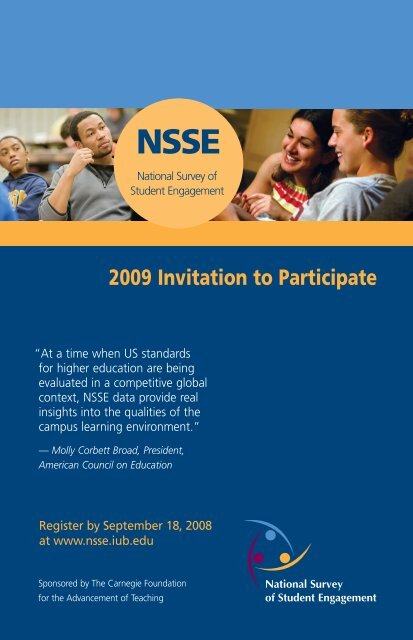
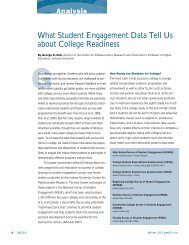

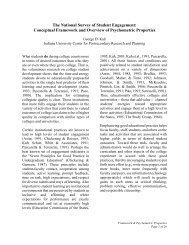
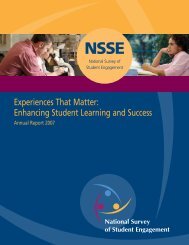
![Cuestionario para el Estudiante Universitarioâ[consent] - NSSE](https://img.yumpu.com/41728892/1/190x245/cuestionario-para-el-estudiante-universitarioaconsent-nsse.jpg?quality=85)
